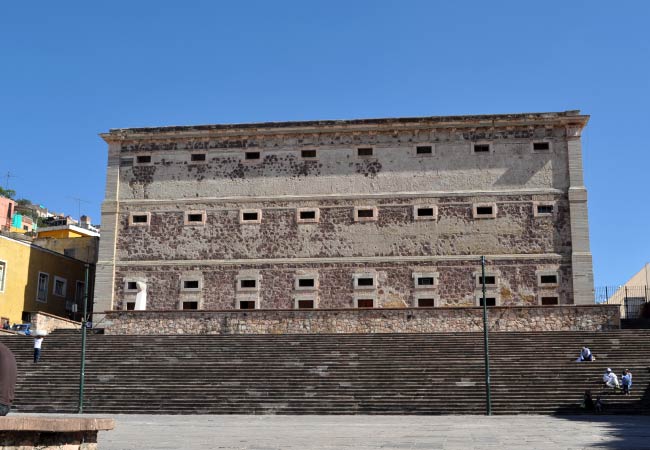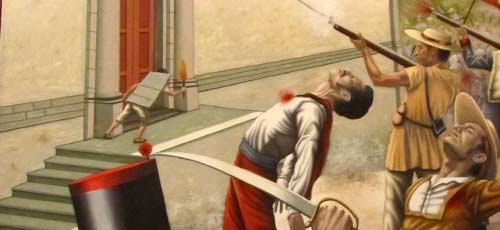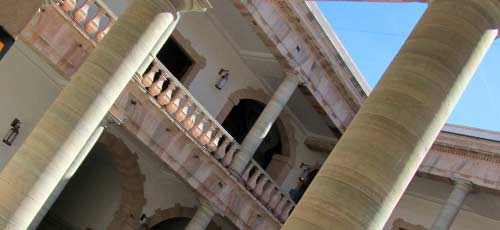GuanajuatoMexicoCity.com
The best independent guide to Guanajuato
GuanajuatoMexicoCity.com
The best independent guide to Guanajuato
Alhóndiga De Granaditas, Guanajuato
The imposing stone walls of the Alhóndiga de Granaditas dominate a small plaza in central Guanajuato, their weathered facades bearing witness to one of Mexico's most pivotal historical moments. This fortress-like structure, now home to the Regional Museum of Guanajuato, played a crucial role in the Mexican War of Independence and remains one of the city's most significant buildings.
More than just a museum, the Alhóndiga represents the birthplace of Mexican independence, where the first major victory against Spanish colonial rule unfolded in September 1810. Today, visitors can explore both its dramatic history and extensive collections that chronicle the region's past from pre-Hispanic times through to the modern era.

The Alhondiga Ganaditas
A Fortress Born from Famine
The Alhóndiga de Granaditas was originally conceived as a practical solution to a recurring problem. Between 1798 and 1809, colonial authorities constructed this massive granary to store grain reserves and prevent the devastating famines that had periodically struck the mining colony when seasonal rains failed. The name itself translates to "grain exchange," reflecting its intended commercial purpose.
The building's architect clearly had more than grain storage in mind. With walls of volcanic stone rising four storeys high, small windows suitable for musket fire, and a single entrance protected by heavy wooden doors, the structure more closely resembled a military fortification than a simple warehouse. This defensive design would prove fateful when revolution came to Guanajuato.
The Battle That Changed Mexico
On 28 September 1810, the Alhóndiga became the focal point of the independence movement's first major confrontation. As Miguel Hidalgo's insurgent forces approached Guanajuato, Spanish soldiers, colonial officials, and wealthy Spanish families barricaded themselves inside the building, along with the region's treasury. They calculated that the fortress-like granary could withstand a siege until reinforcements arrived.
The assault initially stalled against the Alhóndiga's solid defences, until an unlikely hero emerged. Juan José de los Reyes Martínez, a local miner known as "El Pípila" (Turkey Man), volunteered for what seemed a suicide mission. According to legend, he strapped a large flat stone to his back for protection against Spanish musket fire, then crawled to the main entrance carrying tar and a torch. Despite the hail of bullets, he managed to set the massive wooden doors ablaze.
The insurgents poured through the burning entrance and overwhelmed the defenders. The victory gave crucial momentum to the independence movement, though it came at a terrible cost - not only soldiers but also the women and children who had sought refuge inside were killed in the fierce fighting. El Pípila himself died from wounds sustained during his heroic assault.
Retribution and Remembrance
Spanish retribution came swiftly. When colonial forces recaptured Guanajuato, they made an example of the rebellion's leaders. Miguel Hidalgo, Ignacio Allende, Juan Aldama, and Mariano Jiménez were executed, and their severed heads were displayed in iron cages hung from the four corners of the Alhóndiga. For ten years these grim trophies remained, intended as a warning to other would-be revolutionaries, until Mexico finally achieved independence in 1821.
The building's post-independence history reflects Mexico's turbulent 19th century. It served variously as a warehouse, military barracks, and from 1864 to 1948, as the city prison. Each incarnation left its mark on the structure, though the essential fortress-like character remained unchanged.

A painting of El Pipila’s brave actions
The Museum Today
Since 1958, the Alhóndiga has housed the Regional Museum of Guanajuato, transforming this site of conflict into a space for education and cultural preservation. The museum's collection spans millennia, from pre-Hispanic artefacts to contemporary works, though the building itself remains the most compelling exhibit.
Entering through the same doorway that El Pípila once set ablaze (now accessed by stairs rather than at ground level), visitors find themselves in a surprisingly elegant interior. A spacious central courtyard surrounded by two levels of galleries creates an atmosphere far removed from the building's martial exterior. Wide balconies supported by Tuscan-style columns form graceful arches, while the interplay of local green and red stone adds visual warmth to the austere architecture.
The museum's permanent collection occupies fourteen rooms, each focusing on different aspects of regional history and culture. Pre-Columbian galleries display ceramics from the Chupícuaro culture (600 BC to 250 AD), renowned for their distinctive geometric patterns and varied forms. The collection includes pieces donated by prominent local artists José Chávez Morado and Olga Costa, whose own appreciation for indigenous art enriched the museum's holdings.
Colonial period rooms chronicle the Spanish settlement of the Bajío region and Guanajuato's rise as a silver mining centre. Religious paintings and sculptures reflect the pervasive influence of Catholicism in daily life, while a section on the Bourbon Reforms explains the administrative changes that ultimately contributed to independence sentiments.

Visiting the Alhóndiga
The Regional Museum is open Tuesday through Saturday from 10:00 AM to 6:00 PM, and Sunday from 10:00 AM to 3:00 PM (closed Mondays). General admission is 80 pesos, with free entry for children under 13, students, teachers, and senior citizens. The museum provides guided tours and educational programmes, though advance booking is recommended for groups.

The interior of the “Alhóndiga de Granaditas”
Art and Revolution
Perhaps the museum's most striking features are the murals by José Chávez Morado that adorn the main staircases. Painted between 1955 and 1966, these vibrant frescoes - including "Abolition of Slavery" and "Song to Guanajuato" - reinterpret the region's history through a modern artistic lens. The murals transform what could be a simple ascent between floors into a journey through centuries of struggle and achievement.
A dedicated room honours the independence period with maps tracing Hidalgo's route through Guanajuato, period weapons (including the agricultural tools and mining implements used by insurgent forces), and portraits of key figures. One particularly fine oil painting presents an unusually delicate portrayal of Hidalgo, far removed from the bombastic depictions common in official art.
The museum also maintains an extensive collection of ex-votos - small devotional paintings commissioned to give thanks for divine intervention. Dating from 1838 to 1952, these folk art pieces offer intimate glimpses into the hopes, fears, and daily struggles of ordinary people across two centuries.
The Fototeca and Beyond
One of the museum's hidden treasures is the Fototeca Romualdo García, an archive containing over 80,000 photographs documenting Guanajuato from the late 19th century onwards. The work of Romualdo García and his sons captured everything from formal portraits of Porfirian-era elites to candid street scenes, creating an invaluable visual record of the city's transformation into the modern age.
The museum actively engages with contemporary culture through its four temporary exhibition spaces, educational workshops, concerts, and theatrical performances. The Manuel Doblado and Casimiro Chowell halls regularly feature exhibitions exploring archaeological discoveries, artistic movements, and ethnographic studies.
Outside, the plaza fronting the Alhóndiga serves as a principal venue during the Festival Internacional Cervantino, when the fortress walls provide a dramatic backdrop for open-air performances. This annual celebration of arts and culture brings international recognition to Guanajuato while reinforcing the Alhóndiga's role as a living cultural space rather than merely a monument to the past.
Guanajuato Mexico Tourist Guide Navigation
|
| ||||||
|
| ||||||
|
| ||||||
|
| ||||||
|
|
|
| ||||||
|
| ||||||
|
| ||||||
|
| ||||||
|
|










